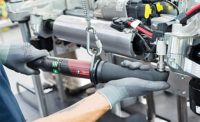After writing this column for six years, I understand the need for brevity. With that in mind, I thought it would be useful to summarize some of the key points that I’ve raised in the past.
I have included the issue in which each column appeared so you can delve into the topic in more detail if desired. As always, please feel free to contact me with your questions, comments or observations.
Engineers should strive to:
- Optimize joint design so that secondary locking methods, such as compounds or lock washers, aren’t required. When needed, match the locking method to the joint characteristics. (September 2007)
- Maintain consistent measurement techniques when performing torque audits. Rotate the fastener a small angle in the tightening direction, preferably with no extensions or adapters between the wrench and socket. For consistent readings, maintain the same auditor and wrench combination, or use a specialized wrench with audit capabilities. Acceptable audit torque should be established on a joint-by-joint basis, as natural relaxation and the presence of torque spikes due to static friction are not constant or predictable. (September 2008)
- Understand the factors that make the relationship between installation torque and bolt tension difficult to predict. This can provide a basis for deciding whether history, testing or reference tables should determine the tightening specification for a given joint. (January 2009)
- Consider the potential of using angle control as a tightening strategy. Tightening a threaded fastener to an angle rather than a torque value eliminates the friction variation that contributes greatly to clamp load uncertainty. However, deciding when to start measuring the angle of rotation, and actually making an accurate measurement, represent a challenge with some joints and tools. As a rule-of-thumb, joints with more consistent friction than stiffness favor torque control, while consistent stiffness and variable friction call for angle control. Joint stiffness variation comes from components bending or yielding during tightening. (January 2010)
- Ensure that each joint in the product is actually required. The most reliable joint is the one that was eliminated. Relative movement and fundamentally different material requirements are in theory the only reason joints need to exist, though repair or replacement is often a practical justification. (January 2011)
Engineers should avoid:
- Focusing on the fastener as the root cause of joint problems. In most cases, the joint design or assembly process is to blame. (June 2007)
- Establishing installation torque based on reference tables, since the assumptions of friction and joint geometry inherent in calculating the values can be far off. Carrying over torque from successful past experience is fine if the joint and application are truly equivalent. Ultimately, this approach tends to be limiting and dangerous. (January 2008)
- Addressing a crisis only when it knocks on your door. Small and mid-sized manufacturers without prior experience with lawsuits are often unprepared for product liability claims. Among the most potentially damaging circumstances is the inability to demonstrate a complete, organized and quantifiable process for making product design and assembly decisions. Imagine attorneys quizzing you and your colleagues about what you did to validate the integrity of a product that someone now claims caused damage or injury. In most classes of engineered products, failure is much more likely at component interfaces than within the structure of a component, so this examination is particularly suitable for joints. (May 2008)
- The most common causes of joint problems in design and assembly. Design examples include not proving that the assumed clamp load was achieved, not considering the effect of the high stress under nuts and bolt heads, and not accounting for joint relaxation when fastening thin parts. Common production oversights include not testing to determine (or confirm) an effective tightening strategy, and not having a plan or equipment for process control. (May 2009)
- Overestimating the accuracy with which analytical methods can predict joint behavior. While they are simple systems to model, bolted joints are heavily influenced by component nonconformities or variations that are impossible to quantify without physical testing. (May 2010)


